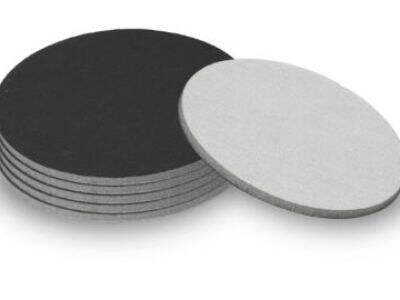Ahoj! Pokud byste chtěli naučit se, jak vybrat správnou šlehačku pro váš lišejník, pak můžete být si jisti, že jste přišli na správné místo! Začali jsme v Aimchamp a, protože známe svou cestu kolem šlechování, těšíme se, že můžeme sdílet to, co víme, abychom vám pomohli s vašimi projekty.
Jak důležité jsou hrubost a velikost
Hrubost a velikost jsou dvěma z nejdůležitějších faktorů, které je třeba brát v úvahu při šlechování. Hrubost je termín pro označení toho, jak hrubá nebo jemná je šlechtačka, a uvádí se v číslech mezi 40 a 600. Nižší číslo - například 40 - naznačuje hrubou šlechtačku. Čím vyšší je číslo, tím jemnější je šlechtačka. Takže si zapamatujte, čím vyšší je číslo, tím jemnější je šlechtačka!
Teď si popovíme o velikosti. Co se týče velikosti, jde jen o průměr lišty. Obvykle dostanete lišty s průměrem 5 až 6 palců. Samozřejmě existují i menší verze, které se hodí do úzkých prostorů nebo možná větší velikost pro rozsáhlé plochy. Tato velikost opravdu ovlivňuje, jak efektivně dokážete lisovat svůj projekt.
Hrubost a kvalita vaší lišty bude mít vliv na výsledek vašeho projektu. Například můžete použít hrubou lištu k odstranění barvy, rezu nebo jiných látek přilnutých na povrch. Ale pokud chcete něco lesklého a vybroušeného, použijete jemnou lištu.
Pro větší projekty může být užitečná větší lišta. To je proto, že větší lišta může pokrýt větší plochu v kratším čase. Ale pokud šlýháte menší projekt nebo pracujete v úzkém prostoru, může být lepší pro vás menší lišta. Je to jen otázka výběru nejlepšího nástroje pro danou práci.
Nejlepší lišty pro různé povrchy
Co potřebovat vědět: Ne všechny šlehačky dělají totéž a některé jsou lepší pro určité povrchy než jiné. Některá obecná pravidla při volbě šlehačky pro různé typy materiálů:
Dřevo: Nejlepší druh hrubosti šlehačky pro šlehaní dřeva se pohybuje od 80 do 120 hrubosti. Pro většinu druhů dřeva stačí šlehačka z oxidu hořečnatého. Ale pokud používáte tvrdší druhy dřeva, jako je dub nebo javor, je dobrým volbou keramická šlehačka, protože vydrží déle a udělá lepší práci.
Kov: Pokud má být kov šlehaný, hledejte šlehačku s hrubostí mezi 120 a 220. Zkuste použít šlehačky z cirkonie nebo keramiky. Tyto šlehačky jsou dostatečně pevné na práci s kovy a neobvykle rychle se neměknou.
Betón: Pro šlehaní betonu budete muset použít šlehačku s hrubostí 16 až 36. Tyto šlehačky jsou vyrobeny pro tento účel a proto jsou velmi účinné při odebírání nátěrů/pomalů z betonu.
Plast: Použijte leštidlo s hrubostí od 220 do 400 pro leštění plastu. Je to účinné a vytváří pěkné dokončení na leštěných plastových povrchů, protože je nejlepší volbou křemenná karbidová nebo oxidová aluminiová deska.
Drap: Drap vyžaduje leštidlo s hrubostí 120 až 220. Nejlépe slouží disk s oxidem aluminia a keramikou, což vám pomůže dobře drap šlehat a dokonce vám pomůže udělat povrch hladší.
Jak vybrat správné leštidlo
Výběr vhodného leštidla může být někdy příliš komplikovaný, ale zde jsou některé užitečné tipy, které vám mohou udělat věci jednodušší:
Prosím, jak hrubé chcete, aby bylo toto leštidlo a jaké velikosti? Zvažte také povrch, který budete šlehat. Pokud jde o různé povrchy, budete potřebovat různé šlehače a leštidla.
Vyberte si ten, který dokáže unést použití a zůstat v dobrém stavu po dlouhou dobu. Musí to být disk, který dokáže dělat práci bez rozpadání se během procesu.
Vyber si ten, který má připojení disku s háčkovou a smyčkovou plochou. Navíc je velmi jednoduché vyměnit nebo upravit disk kdykoli.
Ujistěte se, že si přečtete recenze od dalších zákazníků! Poslechnout si zkušenosti ostatních je dobrý způsob, jak zjistit, zda liší se šlehačka, kterou vás zajímá, funguje dobře a možná bude správnou volbou pro váš projekt.
Vylepšete svůj dům na rozpočet
Takže, pokud máte problém s rozpočtem, tady jsou některé levné substituty pro drahé šlehačky, jako je použití houbiček pro šlehaní. Tyto šlehačky-houbičky jsou úžasné a mohou šlehat jakoukoli zakulacenou plochu. Tyto lze použít opakovaně, protože je lze umýt a znovu použít mnohokrát, takže i šetří peníze.
Další rozpočtově přístupnou možností je drsná síť. Tento otevřeně pramenitý materiál je dostatečně pružný, aby sloužil jako solidní alternativa k papíru na šlehaní. Drsná síť je ve skutečnosti vytrvalejší než tradiční papír na šlehaní a je vynikající pro šlehaní povrchů, které potřebují dokončení odolné proti nosně spotřebnímu dopadu.
Profesionální pomoc při výběru správného šlehačského disku
Tento průvodce by vám měl pomoci vybrat správný šlehačský disk pro konkrétní úlohu; pokud však máte problém rozhodnout, který šlehačský disk použít pro svůj projekt, obraťte se na odborníka, který vám poradí. V Aimchamp máme specialisty na šlehaní, kteří vám jsou ochotni pomoci. Jsou skvělí v tom, aby vám pomohli vybrat správný disk pro jakoukoli úlohu, kterou předložíte. Dokážou doporučit nejlepší zrnitost a velikost pro váš projekt a také vám dát tipy a triky, jak dostat nejvíc z vašeho šlehačského disku.
Nakonec, volba správného šlehačového disku pro váš šlehač udělá všechny rozdíly při dosažení konečných výsledků, které chcete. Vždy si pamatujte, abyste zvážili hrubost a velikost disku a druh povrchu, který budete šlehat. Hledejte pevný disk, který vám může sloužit dlouhou dobu. Takže laď kdykoliv se vás bude nejistota, jak vybrat šlehačový disk, určitě se podívejte na odborníka! Jakmile budete vědět, co dělat s pravým šlehačovým diskem, můžete pomoci každému projektu vypadat úžasně!

 EN
EN
 AR
AR BG
BG HR
HR CS
CS DA
DA NL
NL FI
FI FR
FR DE
DE EL
EL HI
HI IT
IT JA
JA KO
KO NO
NO PL
PL PT
PT RO
RO RU
RU ES
ES SV
SV TL
TL IW
IW ID
ID SR
SR ET
ET MT
MT TH
TH TR
TR FA
FA AF
AF MS
MS GA
GA CY
CY MK
MK EU
EU KA
KA LA
LA NE
NE